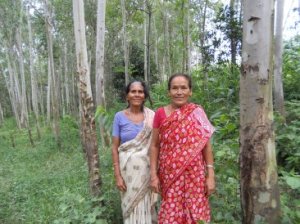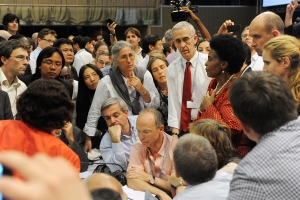This is the second in a series of guest contributions focussed on sharing local experiences from around the world in developing and implementing safeguards in REDD+. The series will feature contributions from Central America, East Africa and Asia-Pacific. In this blog Promode Kant discusses the problems with expecting carbon investments to solve gender and social equity issues.
There is something in the dry desert air that ensures traditions rule; women should remain unborn, and those who still dare arrive should rejoice in being unseen and unheard. Time appears to pass by these harsh lands. It would perhaps take many more monsoons to soften traditions, just that tiny bit to let currents of change flow in.
Sirsa, the driest district of Haryana in northern India, adjacent to the Thar desert, still awaits that flow of change. So when the first CDM forestry project was initiated in India way back in 2007 in the sand dunes of Sirsa, it was a challenge to marry equity with carbon credits.
The CDM rules insist on equity as a central principle around which the project is established. The participation of all concerned in the project has to be truly voluntary and every single project activity should pass the test of ‘no injury’ to the interests of non-participants. And it must result in positive impact on women and socially and economically weaker sections of the local populace.
A legal Society was set up to create and manage the CDM project and any adult person of the area willing to contribute a minimum of 0.05 ha of land could become member of the Society. A total of 227 farmers contributed 370 ha of land for the project. Care was taken that participation was not denied to numerically or socially weaker castes and communities. The minimum land requirement was kept as low as meaningfully possible so that the poorer sections could take part, though, for obvious reasons, the landless could not be a part of the project.
An important requirement of land eligibility was that it should be considered unsuitable for regularly raising agricultural crops, either on account of low productivity or difficulty in management. The second part – difficulty in management – was deliberately kept to accommodate widows, with no adult males in household, who were unable to manage their lands and to whom tree cultivation was a more attractive option.
The voting rights in the management of Society were separated from shareholding which was based on the extent of land contributed for the project. This, it was reasoned, will allow poorer people to have the same decision making rights as richer ones who contributed most of the lands for the project.
So what is the situation today three years after project activities began in 2009? The day to day management of the Society is in the hands of its executive body. The byelaws provide that if the executive committee did not have one third women members the government would nominate as many women as necessary from outside to bring their numbers to the requisite minimum. The implied threat has worked and there are always at least one third women among the executives.
But the worst kept secret in the area is that all the women there are the wives of powerful men in the Society. This was not unexpected. Nobody really hoped things would change for women so easily here. But now more serious trouble is brewing for small farmers because the larger farmers now find other better earning opportunities for their lands and are quietly withdrawing from the project. When the project is due for carbon credit verification later this year there may be no option but to ask for the project to be re-evaluated, because the test of additionality and leakages is sacrosanct in CDM, and large changes in project boundaries can render calculations and checks done earlier meaningless.
Small farmers do not realise it yet and the Forest Department expects the Society to deal with the problem judiciously – Society byelaws expressly prohibit withdrawing from the Project for the entire crediting period of twenty years. But the Society itself is controlled by the better off farmers, and their wives, who are unlikely to punish themselves.
Has the CDM failed then? Maybe burdening CDM with too high expectations on equity is not a sound idea after all – a CDM project, even a large one, is too light an intervention in an area to change the nature of the local society and one may only be preparing grounds for its failure by insisting it does what it cannot.
Inequity in a society sits in its heart, in its deep fissures, in its imbalances.
It is kept in place by the greed of powerful and helplessness of the weak.
It cannot be patched up with a sprinkling of carbon, even if it falls at the right places.
Bringing equity in such a custom ridden society has a high cost. And this cost has to be borne by the larger society – the country government – through its governance policies. There is a limit beyond which it cannot be pushed on to private individuals who dare to take up a venture as risky as a CDM forestry project. For them it should suffice if they follow the laws honestly, in letter and in spirit.
By Dr Promode Kant, Director, Institute of Green Economy
For more information on equity in REDD+, please visit the REDD-net website’s equity page.








